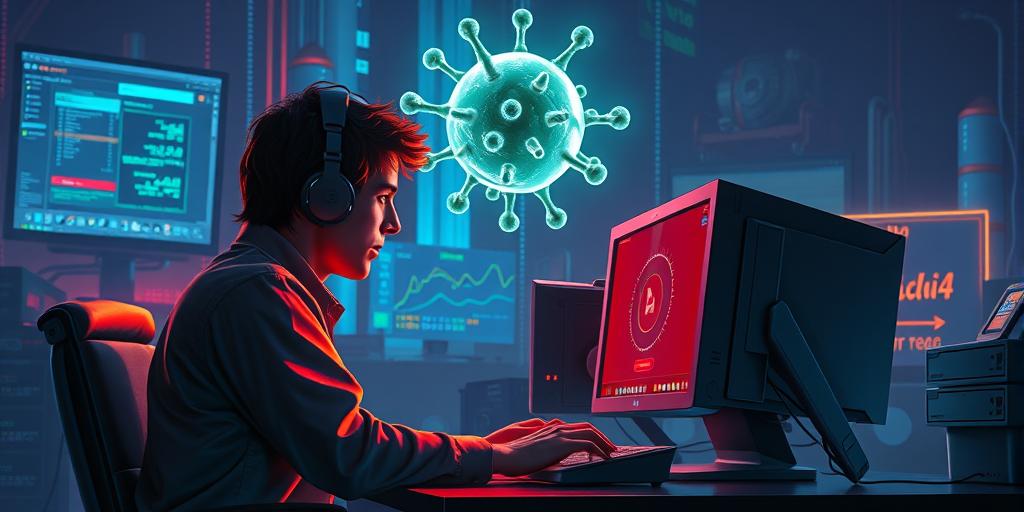Did you know that in the 90s, our biggest digital worry was antivirus software? Before the days of complex ransomware schemes and sophisticated phishing attacks, the digital world felt a lot simpler. But what made the 90s so unique in this respect? Let’s take a trip down memory lane and explore the fascinating history of our digital anxieties. Prepare to be surprised by how much things have changed!
The Rise of the PC and the Dawn of Digital Threats
The 1990s saw the explosion of personal computers (PCs) into the homes and offices of millions. This mass adoption created a fertile ground for early forms of malware. But the threats were primitive by today’s standards. The primary concern wasn’t data breaches or identity theft—it was viruses. Simple computer viruses, that is, which would spread via floppy disks or infected files downloaded via dial-up modem, infecting computers and occasionally causing minor damage or annoyance. The 1990’s digital landscape was a simpler, though not less concerning, digital world than what we know today. Unlike now, there was no expectation of privacy on the internet. The widespread use of dial-up internet meant that internet users had relatively slow internet connection speeds, making malware less easily spread than it is today. Think of it – viruses spread through shared floppy disks, a far cry from the intricate web of interconnected devices we have today. This relative simplicity is a key part of understanding why antivirus software was the dominant digital concern.
The Early Days of Antivirus Software
Early antivirus software was a far cry from the sophisticated, multi-layered protection we have today. These programs often relied on signature-based detection, meaning they could only identify and remove viruses they had already been programmed to recognize. This was in contrast to the more advanced forms of malware detection such as heuristic detection and machine learning that we have available today. Imagine the limited capacity of that software, and then also consider the simplicity of the virus threats at the time. Updating this software was a tedious process often relying on physical media such as floppy disks or CDs. This is significantly different from how easily our antivirus software updates today.
Beyond Antivirus: Other Digital Concerns of the 90s
While antivirus was king, other digital concerns emerged during this era. Email spam started becoming a growing problem, although it was a far cry from the deluge of unsolicited emails we see today. The concept of online privacy was still nascent; the internet was a largely unregulated Wild West. But compared to the multifaceted threats we face today, the relative simplicity of 90’s malware made antivirus software the most prominent security concern.
The Lack of Sophisticated Attacks
The scale and sophistication of cyberattacks today are unimaginable compared to the 90s. Today’s hackers deploy advanced techniques like ransomware, phishing scams, and denial-of-service attacks, affecting individuals, businesses, and even entire nations. Back then, the scale and sophistication of such attacks were limited, and most digital threats were limited to relatively simple computer viruses.
The Evolution of Cyber Threats
The digital landscape has evolved dramatically since the 1990s. The rise of the internet and mobile devices has created a far more interconnected and vulnerable environment. Sophisticated malware, phishing attacks, and data breaches are now commonplace. The early 1990’s marked a time of relatively simple antivirus software and simple computer viruses, a stark contrast to today’s advanced cyber security threats. The evolution of cyber threats has necessitated more sophisticated cybersecurity tools and strategies, making antivirus software just one part of a broader security approach.
The Modern Cybersecurity Landscape
Today, comprehensive cybersecurity strategies incorporate far more than just antivirus software. We now need firewalls, intrusion detection systems, data encryption, regular software updates, and robust security awareness training. Multi-factor authentication is also a key part of a robust cybersecurity strategy today, whereas it wasn’t even a concept in the 1990s.
A Simpler Time, a Simpler Threat
In conclusion, while the 90s presented their unique set of digital challenges, the relative simplicity of the primary threat—computer viruses—meant that antivirus software was the only thing most people worried about. The evolution of technology and the increasing sophistication of cyberattacks have dramatically transformed the digital threat landscape. Today, a comprehensive approach to cybersecurity is vital to protect ourselves and our data in this increasingly complex digital world. Don’t get left behind! Upgrade your cybersecurity today and protect yourself from the ever-evolving threats of the modern digital age!




